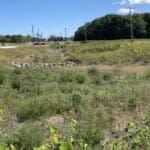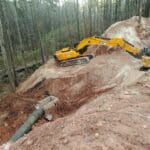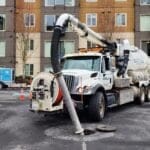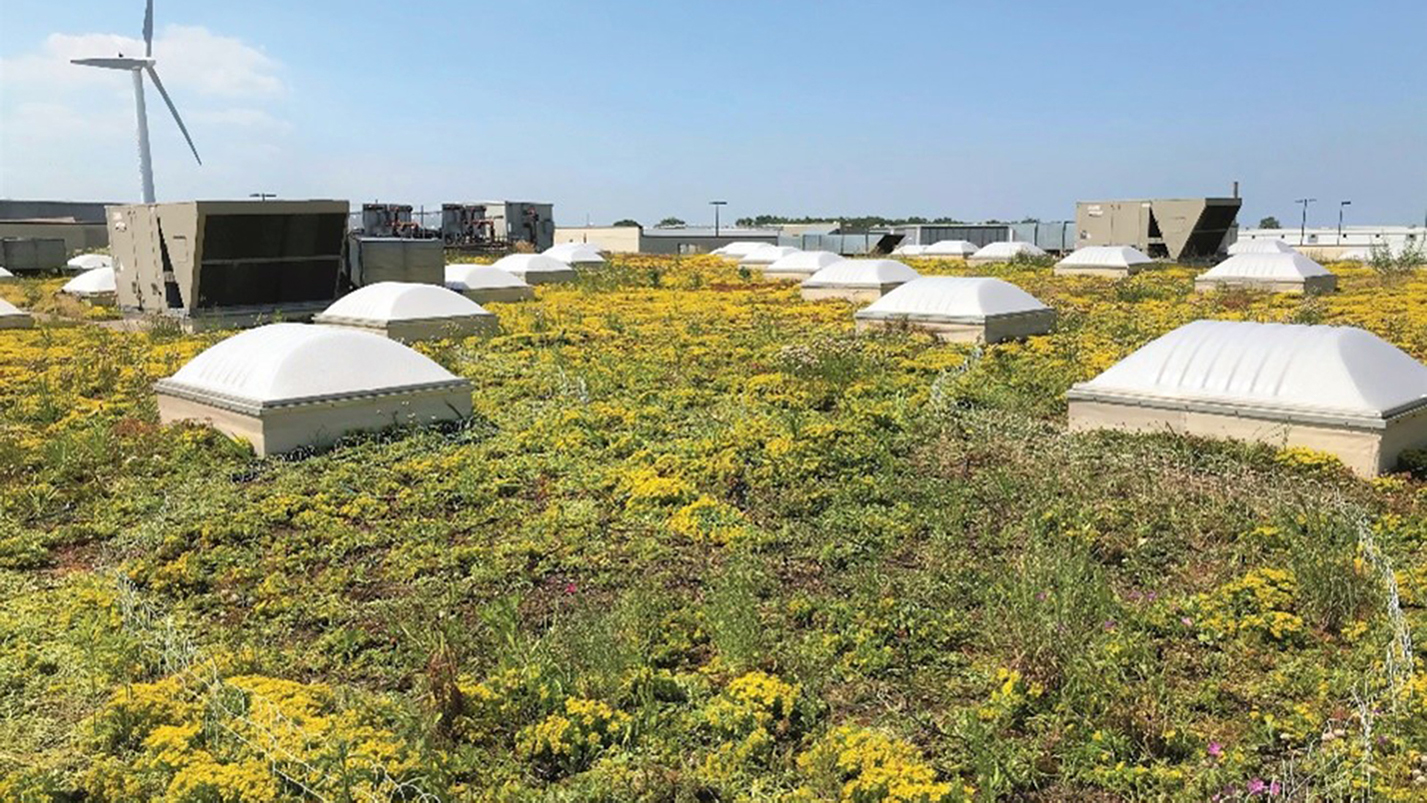City of Philadelphia
The City of Philadelphia has enacted a Stormwater Ordinance in order to maintain a healthy environment for the citizens of Philadelphia, prevent flooding, protect drinking water sources, and comply with the Federal Clean Water Act. The City of Philadelphia is the permitting authority for all land disturbing activities and requires the land owner to maintain all on-site stormwater control facilities and all open space areas (e.g. parks or “green” areas) required by the approved stormwater control plan. The City of Philadelphia will only provide construction permits to projects that establish a plan to manage stormwater runoff occurring during the construction process. Stormwater fees will be calculated and collected by the city. Stormwater credits and grants are available to non-residential properties that engage in stormwater best management practices and/or maintain stormwater management facilities. The City of Philadelphia, under the NPDES program, also has the authority to inspect properties for noncompliance and can issue a notice of violation (NOV) for any deficiency or infraction onsite. Property owners are responsible for the maintenance of any stormwater facilities or practices located on the property. The City of Philadelphia has the authority to inspect stormwater facilities and practices in order to ascertain that they properly maintained and functioning.
Stormwater Fee
Non‐residential customers’ fees are based on the measured gross area and impervious area on their parcels. The rates for each of these rate components are: $0.526 per 500 square feet of gross area and $4.145 per 500 square feet of impervious area. The stormwater charge for a parcel is equal to: (gross area rate * gross area of the property) + (impervious area rate * impervious area of property).
Gross Area (GA): All of the parcel area within the legally described boundaries except streets, medians, and sidewalks in the public right-of-way.
Impervious Area (IA): A surface, which is compacted or is covered with material that restricts infiltration of water, including semi-pervious surfaces such as compacted clay, most conventionally hard-scaped surfaces such as streets, driveways, roofs, sidewalks, parking lots, attached and detached structures, and other similar surfaces.
Credits
Eligibility
Customers on a Non-residential or Condominium parcel with at least five-hundred (500) square feet of gross area and whose water, sewer, and SWMS accounts(s) are not past due are eligible to apply for credits.
Impervious Area Reductions (IARs) Credit
PWD currently offers IARs for the following five categories:
- Tree Canopy Cover
- Roof Leader/Downspout Disconnections
- Pavement Disconnections
- Green Roofs
- Porous Pavement
IARs result in a direct reduction of the billable IA on a parcel. The customer must demonstrate that the IARs calculated on the parcel meet the requirements defined below.
Note: IARs require ongoing maintenance in order to maintain their effectiveness and are subject to renewal requirements.
Calculation of SWMS Charge with Credits
In the case of parcels that are eligible for one or more classes of credits and/or IARs, the total monthly IA and GA charges are calculated in the following sequence:
– Step 1: Determine any areas that meet the IAR criteria and subtract the total IAR area from the billable IA.
– Step 2: Determine any applicable credits. The approach used in calculating the IA and GA credits varies depending on a property’s drainage characteristics and existence of an active NPDES permit for stormwater industrial discharge activities. The IA and GA credits are calculated as follows:
i. NON-SURFACE DISCHARGE Areas without NPDES Credits: For areas of a property that do not discharge stormwater to a surface water body, applicable credits are calculated as follows:
• The IA Credit is calculated by applying an 80% maximum credit factor to the parcel’s IA square footage that is managed (IA Managed).
• For the GA underneath the IA Managed, the GA Credit is calculated by applying an 80% maximum credit factor to the square footage of IA Managed.
• For any open space areas (GA minus IA), a GA Credit up of 80% may be applied, as applicable
ii. NON-SURFACE DISCHARGE Areas with NPDES Credits: For areas of a property that do not discharge stormwater to a surface water body and the property has an active NPDES permit for industrial stormwater discharge activities, applicable credits are calculated as follows:
• The IA Credit is calculated by applying an 87% maximum credit factor to the parcel’s IA square footage that is managed (IA Managed).
• For the GA underneath the IA Managed, the GA Credit is calculated by applying an 87% maximum credit factor to the square footage of IA Managed.
• For any open space areas (GA minus IA), a GA Credit maximum of 87% may be applied, as applicable.
• If the property is not eligible for any GA or IA credits, then the property will receive a 7% credit towards both the IA and GA square footage.
iii. SURFACE DISCHARGE Areas without NPDES Credits: For areas of a property that discharge stormwater to a surface water body, applicable credits are calculated as follows:
• The IA Credit is calculated by applying a 90% maximum credit factor to the parcel’s IA square footage that is managed (IA Managed).
• For the GA underneath the IA Managed, the GA Credit is calculated by applying a 90% maximum credit factor to the square footage of IA Managed.
• For any open space areas (GA minus IA), a GA Credit maximum of 90% may be applied, as applicable.
iv. SURFACE DISCHARGE Areas with NPDES Credits: For areas of a property that discharge stormwater to a surface water body and the property has an active NPDES permit or industrial stormwater discharge activities, applicable credits are calculated as follows:
• The IA Credit is calculated by applying a 97% maximum credit factor to the parcel’s IA square footage that is managed (IA Managed).
• For the GA underneath the IA Managed, the GA Credit is calculated by applying a 97% maximum credit factor to the square footage of IA Managed.
• For any open space areas (GA minus IA), a GA Credit maximum of 97% may be applied, as applicable.
– Step 3: The final billable IA and GA (Final IA and Final GA) are calculated as the total IA and GA minus any applicable IA and GA credits, determined in Step 2.
– Step 4: The IA and GA charges are then calculated based on the Final IA and GA square footage (calculated in Step 2) and the IA and GA rates defined in PWD Regulations, Section 304.0.
Gross Area Stormwater Credit
Two options are available to customers to receive GA Credit.
– Option 1: Management of the First-Inch of Runoff (Impervious Area Only)
GA Credit is automatically achieved when a parcel is approved for IA Credit through management of the first inch of runoff. The area that receives IA Credit will also receive an equivalent amount of GA Credit for the land area underneath the IA.
– Option 2: GA Credit Based on NRCS-CN (Open Space Only)
This option is only applicable to the open space of a parcel. Under this option, the customer must demonstrate a Natural Resource Conservation Service Curve Number (NRCS-CN) that meets one of the values contained in the Curve Number Scale found in Appendix 1. The CN represents the runoff potential for a particular soil and ground cover.
A percent reduction is applied for each whole number below a CN of 75. A CN of 55 may yield the maximum applicable GA Credit. The percent reduction that is applied varies depending on a property’s discharge characteristics and the existence of a NPDES permit for industrial stormwater discharge activities. The CN Scale in Appendix 1 provides the GA Credit associated with the different scenarios. More information on NRCS-CN is available in the Stormwater Management Guidance Manual.
Credits Application Processing
PWD will conduct technical review of credits only after receipt of a complete application, including the fee and all required supporting documentation. PWD will review a credits application only if the customer’s water, sewer, and stormwater charge payments pertaining to the parcel are current.
Site Inspections
After a customer submits a credits or credits renewal application, PWD may inspect the parcel to verify the information provided in the application and in the supporting documentation. It is the responsibility of the customer to allow PWD access to the parcel.
Following submission of a credits or credits renewal application, the customer shall grant the City, its employees, or authorized agents permission to enter the parcel on providing forty-eight (48) hour written notice and, in any case, at reasonable times and without unreasonable disruption, to inspect the parcel to ensure that the information provided in the application accurately represents the current parcel conditions.
Grants
Stormwater Management Incentives Program Grant
Eligibility
Only non-residential properties are eligible for SMIP grant funds. Applicants must be owners of the property or have permission from the property owner(s). The applicant cannot be an agency with the City of Philadelphia, the Commonwealth of Pennsylvania or any United States Department or Federal Agency. Use of funds is restricted to projects that support the design and construction of stormwater mitigation measures. These may include, but are not limited to: detention and retention basins, green roofs, porous paving, and rain gardens.
Evaluation Requirements
Projects will be evaluated based on a variety of criteria, including, but not limited to, the total volume of runoff managed, cost-competiveness, environmental and educational benefits. Competitive applications will limit grant requests to $100,000 per impervious acre managed or less and manage at least the first one inch of stormwater runoff. All recipients will be expected to execute an Economic Opportunity Plan and Operations & Maintenance Agreement as part of the subgrant agreement.
Greened Acre Retrofit Program Grant
Eligibility
Funding for the Greened Acre Retrofit Program (GARP) is reserved for stormwater retrofit projects on private property in the combined sewer area only. Properties undergoing redevelopment are not eligible for GARP funding and must comply with PWD’s Stormwater Regulations. Recipients of the grant funds are limited to companies and project aggregators that can assemble large areas, often over multiple properties, for stormwater management projects. The recommended minimum project size is 10 acres.
Evaluation Requirements
GARP applications will be evaluated based on a variety of criteria including total area managed, cost to PWD, quality of long-term maintenance plan and availability of matching funds. Competitive applications will limit grant requests to $90,000 per impervious acre managed or less. Agreements or contracts with any participating property owners must be included in the application.
Stormwater BMPs
Green Roofs
Green roofs consist of a layer of vegetation that completely covers an otherwise conventional flat or pitched roof. The hydrologic response of a green roof bears closer resemblance to a lawn or meadow than impervious surface. The green roof system is composed of multiple layers including waterproofing, a drainage layer, engineered planting media, and specially selected plants. Vegetated roof covers can be optimized to achieve water quantity and quality benefits. Through the appropriate selection of materials, vegetated covers can provide rainfall retention and detention functions.
Rain Barrels
Rain barrels, cisterns, and tanks are structures designed to intercept and store runoff from rooftops. Rain barrels are used on a small scale, while cisterns and tanks may be larger. These systems may be above or below ground, and they may drain by gravity or be pumped. Stored water may be slowly released to a pervious area. This technique only serves an effective stormwater control function if the stored water is emptied between most storms, freeing up storage volume for the next storm. Irrigation as a use for runoff stored in a cistern is not an acceptable strategy for meeting the Regulations.
Filter Strips
Filter strips are densely vegetated lands that treat sheet flow stormwater from adjacent pervious and impervious areas. They function by slowing runoff, trapping sediment and pollutants, and in some cases infiltrating a portion of the runoff into the ground. Filter strips are a sensible and cost-effective stormwater management pretreatment option applicable to a variety of development sites including roads and highways.
Filters
Filters are structures or excavated areas containing a layer of sand, compost, organic material, peat, or other filter media. They reduce pollutant levels in stormwater runoff by filtering sediments, metals, hydrocarbons, and other pollutants. Filtered stormwater may be infiltrated or released to a sewer or receiving water. Depending on design, the filter media may provide significant detention time or may be combined with an outlet control.
Bioinfiltration/Bioretention
Bioinfiltration/Bioretention systems use surface storage, vegetation, a select growing medium, flow controls, and other components to meet stormwater management goals. These systems may be referred to by a variety of names such as bioinfiltration areas, biofilters, rain gardens, or recharge gardens. On a small scale, these systems may be contained inside planter boxes. This section will refer to all these systems as bioretention.
Detention Basins
Detention basins are constructed to provide temporary surface or subsurface storage of runoff and function hydraulically to attenuate stormwater runoff peaks. Traditional detention basins function primarily to provide water quantity control. The designer should note that detention basins can also be configured to provide water quality treatment. These designs are referred to as dry extended detention basins. More information on dry extended detention basins can be found in the Pennsylvania Stormwater BMP Manual.
Berms
Berms and retentive grading techniques use a site’s topography to manage stormwater and avoid erosion. They may function alone in grassy areas or may be incorporated into the design of other stormwater control facilities such as bioretention and constructed wetlands. They are landscaped features placed parallel to existing contours that direct runoff while promoting retention and infiltration of stormwater.
Swales
A swale is an open channel vegetated with a combination of grasses and other herbaceous plants, shrubs, and trees. A traditional swale reduces peak flow at the discharge point by increasing travel time and friction along the flow path. A swale provides some infiltration and water quality treatment; these functions can be enhanced by adding check dams periodically along its length. Swales planted with turf grass provide some of these functions but turf grass is not as effective as deeper-rooted vegetation at decreasing peaks, allowing infiltration, and decreasing erosion. A swale can be more aesthetically pleasing than a concrete or rock-lined drainage system and is generally less expensive to construct.
Constructed Wetland
Constructed Wetlands are shallow marsh systems planted with emergent vegetation that are designed to treat stormwater runoff.
Wet Pond/Retention Basin
Wet Ponds/Retention Basins are stormwater basins that include a substantial permanent pool for water quality treatment and additional capacity above the permanent pool for temporary runoff storage.
Subsurface Vaults
Subsurface vaults are underground structures designed primarily to reduce peak stormwater flows, although in some cases they may allow infiltration. They are usually constructed of either concrete or corrugated metal pipe (CMP) and must account for the potential loading from vehicles. Pretreatment structures can be used at the inlet to treat stormwater runoff and remove debris. A permanent pool can also be incorporated to dissipate energy and improve the settling of particulate stormwater pollutants. Dry systems are primarily used for volume control or in combination with pretreatment, whereas wet systems include a permanent pool and provide water quality treatment.
Subsurface Infiltration
Subsurface infiltration systems are designed to provide temporarily below grade storage infiltration of stormwater as it infiltrates into the ground. Dry wells, infiltration trenches and beds are a few examples of these types of systems.
Porous Pavement
Porous pavement provides the structural support of conventional pavement, but allows stormwater to drain directly through the surface into the underlying base and soils, thereby reducing stormwater runoff. There are porous varieties of asphalt, concrete, and interlocking pavers. Porous pavements are designed with an open graded subbase that allows water to pass through to the native soil and provides temporary storage.
Inlet & Outlet Controls
Inlet and outlet controls are the structures or landscape features that manage the flow into and out of a stormwater management facility. Flow splitters, level spreaders, curb openings, energy dissipaters, traditional inlets, and curbless design are all examples and elements of inlet controls. Outlet controls regulate the release of stormwater from a management facility. Examples of outlet controls include risers and orifices, underdrains, permeable weirs, positive overflows, and impervious liners. Outlet control structures limit flow to meet release rate requirements and bypass larger flows to prevent re-suspension of sediment, hydraulic overload, or erosion of management practices.
LINKS:
Philadelphia Stormwater Grants Application Guide
Philadelphia Stormwater Incentives Grant Manual
Philadelphia Stormwater Management Incentives Program Grant Fact Sheet
Philadelphia Greened Acre Retrofit Program Grant Fact Sheet
Philadelphia Stormwater Management Service Charge Appeals
Philadelphia Rates and Charges (Effective 2019)
Stormwater Management Guide Chapter 1 – Introduction
Stormwater Management Guide Chapter 5 – Post Construction Stormwater Management Plans
Philadelphia Stormwater Management Page

 Kenosha, Wis. Highway KR Regenerative Stormwater ConveyanceThe Root-Pike Watershed Initiative Network Kenosha County, and others worked with AQUALIS to design and implement an innovative solution for stormwater control along Highway KR.
Kenosha, Wis. Highway KR Regenerative Stormwater ConveyanceThe Root-Pike Watershed Initiative Network Kenosha County, and others worked with AQUALIS to design and implement an innovative solution for stormwater control along Highway KR. Durham, N.C. Sinkhole Leads to Stormwater System RehabilitationThe tenant on this property noticed a depression that opened to the ground below and notified the property owners.
Durham, N.C. Sinkhole Leads to Stormwater System RehabilitationThe tenant on this property noticed a depression that opened to the ground below and notified the property owners.

